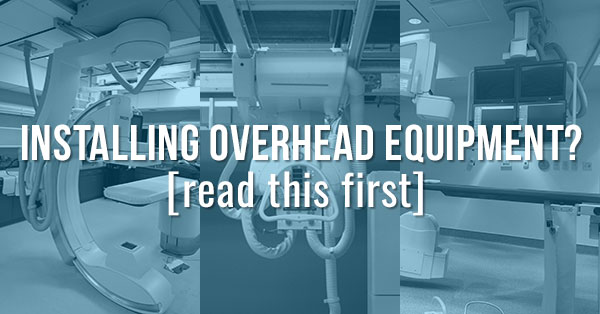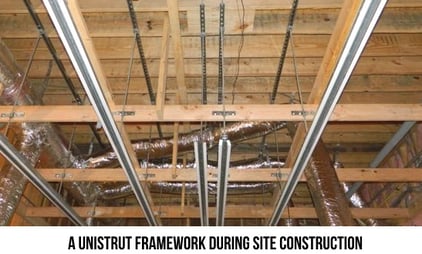
Updated: May 28, 2025 : 3 min read
What Is 'Unistrut' & Why Does My Medical Facility Need It?
If your facility is going to have medical imaging equipment installed, and that equipment has any ceiling-mounted components- you're probably going to see the word "Unistrut" somewhere among the plans for your project. You may already have it. You may have to have a contractor install it. In either case, you're going to need it.
In the following passages, we'll give you the scoop on what Unistrut is, why it's so important, and how it needs to be handled to ensure that you and your equipment come out with successful installation of an imaging system that's ready to serve.
Unistrut Support for Medical Equipment
Below are the Unistrut questions our team is asked most often, and their answers. Some of the answers will vary depending on what type of equipment you hope to install, but this article will get you pointed in the right direction for success.
What is Unistrut?
Unistrut is a brand name of the construction material, strut channel. It is the most prominent and widely-used brand of this material so, much like the widespread use of "Kleenex” to refer to all facial tissues or "Band-Aid" to refer to all adhesive bandages, the Unistrut name is frequently used to refer to all strut channel.
Functionally, strut channel is a series of threaded rod and metal channel used to form a ceiling-mounted support structure for anything from lighting, to injectors, to overhead system components.

Why is it required?
Any component of medical imaging equipment that is suspended from the ceiling needs to have an adequate structure in place to accommodate its weight. Without the proper structure, suspended equipment runs the risk of severe damage or, even worse, injuring someone in the event of a fall or collapse. This could include something as small as a ceiling-mounted injector, or as large as the “C” of a ceiling-mounted cath lab.
My old system has Unistrut already, will it work?
Not necessarily. While a grid of unistrut is required for any overhead equipment installation, the specifications required by each manufacturer vary. For example; a Siemens R/F room may call for the strut channel to run in one direction while a GE room may call for it to run in the opposite direction. Adjustments may be necessary depending upon the degree of similarity between your existing system and the one coming in.
Do I need to replace ALL of my existing Unistrut?
While anything is possible with a change in equipment, most likely the answer is- probably not. There is frequently a possibility of adding unistrut to the existing structure to meet the OEM requirements for the new equipment. We’ve also seen sites with "layers" of strut in place from previous installations be able to simply subtract portions to meet the requirements for incoming equipment.
It is especially important to note the minimum distance from the finished floor to the bottom of the Unistrut. Each system's specifications have a minimum distance that needs to be taken into consideration. If you install Unistrut below this minimum, there could be a variety of issues – anything from an increased chance you’ll hit your head on an overhead monitor suspension to an inability to install a cath lab because the “C” would hit the floor.
Where do I put the Unistrut?
Directions for strut placement will be included in the site-specific drawings that are created for your equipment. These instructions will include exact location, number of pieces required, distance between pieces of Unistrut, and directions for how level it needs to be over a set distance.
How level does Unistrut need to be?
Some overhead equipment, such as ceiling-mounted cath labs, is quite heavy and requires precision for multiple reasons. These include system clearance from the floor throughout the range of motion, suspended component interaction with fixed components below, and more. For example, we've seen cath lab models that require their Unistrut to be level within 1/16” over any 39” span.
Who is responsible for installing Unistrut?
It is up to a site's general contractor to order and install the needed Unistrut. Through the process of creating the site-specific drawings, everything required to build the room should be properly detailed. It is up to the architect to incorporate the drawings into the overall plan. This will be the contractor's guide as they handle the Unistrut. Getting the information the architect and, ultimately, the contractor will need is part of the customer's site preparation responsibilities.
NOTE: While the drawings provided will detail what the OEM calls for in proper installation of the equipment, it is up to the site’s architect and structural engineer to determine the feasibility of suspending the weight of the equipment from the site’s structure. Failure to do so could result in serious safety concerns.
The Takeaway
In the end, the best thing to do is to remain in regular communication with all the tradespeople involved with your project. And when information comes your way- share it. Remember:
• The equipment site planner needs your architect's drawings to make the specification drawing.
• Your architect needs the specification drawing to incorporate into the final plan.
• Your contractor needs the final plan to install the Unistrut.
If you have questions about project management for your medical imaging equipment installation, we're ready to help. Contact us to learn more about what your project might look like.

Kenn Dextrom
Kenn Dextrom is the Director of Product Manager at Block Imaging. He aims to provide clear direction and careful planning for Interventional Cath Lab buyers and working with the Block Imaging product team to provide excellent solutions for our customers. Out of the office, he spends most of his time keeping up with his wife and their three energetic sons.




